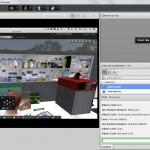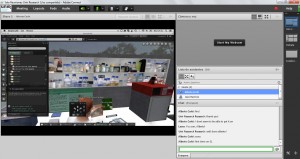Students and 3D avatars: a perfect pairing

Maybe you think that your university or high school is not exploiting all the resources that Internet has available. Here we are going to show you two innovative learning initiatives that will surprise you. Imagine: you are a 3D avatar and you can choose the environment: city, zoo, lab, mountain or even Jurassic Park.
These two initiatives were selected as “Innovations” to form part of the European Commission funded Project HOTEL (Holistic Approach to Technology Enhanced Learning). Both Innovations have been between those assessed by HOTEL experts, through the Exploratorium Lab on Higher Education ran by UNIR Research, Universidad Internacional de La Rioja.
“The student can edit an avatar, design own spaces, collaborate and communicate with peers and learn better than never before”, comments Pasi Mattila, CEO at Finpeda (Finland) and innovator of HoTEL.
Mattila’s project is Meshmoon 3D (Finpeda TOY immersive learning environment), a 3D multiuser social collaboration platform that allows communicating and learning better than Skype or Adobe Connect connection. “We believe 3D brings added value”, states the researcher.
This platform means going towards Internet and mobile access, making it much more interesting and easy to use. Last month, the project was tested by UNIR Research experts, whose avatars flew, jumped and travelled.
The project has been implemented in OSAO Vocational Unit and in a high school in Oulu. The next steps will be the development of new services (3D books), the access to a content library (teacher and student materials), to improve graphics and usability, and adding new customers to develop product further.
“We would like to use the system in participatory planning of new schools and school building projects”, asserts the innovator. He and his team also want to improve the services in vocational education or business trainings for industry use.
“For example, if there are patients who are separated for certain time frame from the rest of the community, or how to handle tricky or dangerous situations of business language learning”, adds.
Virtual genetics laboratory
The main aim of the second learning initiative, The virtual genetics laboratory, –which forms one part of the SWIFT project (Second World Immersive Future Teaching)– is to investigate the student experience and learning outcomes from a virtual genetics laboratories and compare them with outcomes from other modes of learning.
“It was not intended that this approach would replace real-life laboratory activities but complement them, improving the learning experience and providing an example for other sciences”, explains Sarah Gretton, biology teaching fellow and head of Pedagogy at the University of Leicester.
These activities have allowed educators to introduce students to specific learning concepts before they encounter them in a real laboratory situation. Molecular biology processes are sometimes difficult for the students to comprehend as they occur at a level which is not directly visualised.
“The molecular level animations which take place whilst the students are undertaking the laboratory protocols in the virtual lab allow students to grasp what is occurring at this level before they undertake these procedures in a real laboratory”, adds Gretton.
The virtual laboratory also familiarises the students with the process and the equipment required. Finally, it allows the students to carry out molecular procedures they wouldn’t have time to conduct in a real life laboratory.
The genetic screening lab –which is one of 3 virtual laboratories developed as part of the SWIFT project– has been implemented as part of the Forensics module on the University of Leicester’s Natural Sciences programme.

